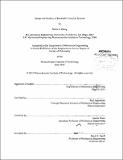Design and analysis of jammable granular systems
Author(s)
Cheng, Nadia G. (Nadia Gen San)
DownloadFull printable version (12.30Mb)
Other Contributors
Massachusetts Institute of Technology. Department of Mechanical Engineering.
Advisor
Karl Iagnemma and Anette Hosoi.
Terms of use
Metadata
Show full item recordAbstract
Jamming--the mechanism by which granular media can transition between liquid-like and solid-like states-has recently been demonstrated as a variable strength and stiffness mechanism in a range of applications. As a low-cost and simple means for achieving tunable mechanical properties, jamming has been used in systems ranging from architectural to medical ones. This thesis explores the utility of jamming for robotic manipulation applications, both at a fundamental level of understanding how granular properties affect the performance of jammed systems, and at a more applied level of designing functional robotic components. Specifically, the purpose of this thesis was to enable engineers to design jammable robotic systems in a principled manner. Three parallel yet related studies were conducted to work towards this goal. First, an experimental analysis was conducted to determine whether the bulk shear strength of granular systems can be correlated with grain properties-such as ones concerning shape, size distribution, and surface texture-extracted from 2D silhouettes of grains. Second, a novel medium composed of a mixture of hard and soft spheres was proposed to achieve variable strength and stiffness properties as a function of confining pressure; experimental analysis was conducted on this system with not only varying confining pressures but also varying mixing ratios of hard and soft spheres. Finally, the design and analysis of a novel jammable robotic manipulator-with the goal of maximizing both the strength and articulation of the system-is presented.
Description
Thesis (Ph. D.)--Massachusetts Institute of Technology, Dept. of Mechanical Engineering, 2013. Cataloged from PDF version of thesis. Includes bibliographical references (p. 102-110).
Date issued
2013Department
Massachusetts Institute of Technology. Department of Mechanical EngineeringPublisher
Massachusetts Institute of Technology
Keywords
Mechanical Engineering.